WEDNESDAY, AUGUST 31, 2016
62.1°, dark sky and pouring rain this morning. I just returned from riding the perimeter in the cart to check fences and make sure the critters of the forest didn't stop by for a meal last night. The various plants can't possibly be as tasty as they were a couple weeks ago but the well-mowed grass in between all the gardens grows quickly and might be enticing.
During the past week, I have received three phone calls asking if it is too early to trim back daylilies. It's been so dry this season that no daylilies look the way we wish they would. Now is the time that the late bloomers typically provide nice color when other flowers bloomed extra early or stopped blooming because of the heat. Yes, the late bloomers are blooming but their foliage shows the stress caused by those multiple 90° days.
Here at the flower farm, we begin trimming back the daylilies now for a couple reasons. We try to get through as many rows as possible to trim back the foliage and spent flower scapes, and pull out the debris at the base of the clumps. This reduces the possible carry-over of fungal issues or insects from this year to the next. We trim to 3"-4" above the ground and after the clean up I try to spray everything with horticultural oil. That oil is the one used by orchardists in the spring to suffocate insects and insect eggs that might be hiding on the bark of the fruit trees such as apples, pears, plums and cherries. It's commonly used and is easy to apply. I use about a third of what is recommended mixed with water with a squirt of dish detergent added to serve as a sticker. That helps the oil hold onto the plant better. As I spray I try to be sure to direct the spray to the spent scapes which once cut are hollow inside and can become hiding places for insects. Hort oil is available at agricultural or hardware type stores, is not toxic and is worth the effort.
During the past week, I have received three phone calls asking if it is too early to trim back daylilies. It's been so dry this season that no daylilies look the way we wish they would. Now is the time that the late bloomers typically provide nice color when other flowers bloomed extra early or stopped blooming because of the heat. Yes, the late bloomers are blooming but their foliage shows the stress caused by those multiple 90° days.
Here at the flower farm, we begin trimming back the daylilies now for a couple reasons. We try to get through as many rows as possible to trim back the foliage and spent flower scapes, and pull out the debris at the base of the clumps. This reduces the possible carry-over of fungal issues or insects from this year to the next. We trim to 3"-4" above the ground and after the clean up I try to spray everything with horticultural oil. That oil is the one used by orchardists in the spring to suffocate insects and insect eggs that might be hiding on the bark of the fruit trees such as apples, pears, plums and cherries. It's commonly used and is easy to apply. I use about a third of what is recommended mixed with water with a squirt of dish detergent added to serve as a sticker. That helps the oil hold onto the plant better. As I spray I try to be sure to direct the spray to the spent scapes which once cut are hollow inside and can become hiding places for insects. Hort oil is available at agricultural or hardware type stores, is not toxic and is worth the effort.
Trimming back the foliage makes digging and dividing the daylilies that much easier. They weigh less and you are less likely to get a scape in the eye when you bend over to pick up a clump. The absence of leaves makes it easier to see how the plant has been growing and where to make your divisions based upon how you will use the plant once it is divided. We pot up several fans in gallon and six quart pots for the following year and line the rest out in rows to keep our stock going. Depending upon popularity, Gail plants multiple plants in 3 and also 5 gallon pots for gardeners who want a better deal on a special plant or who want bigger garden impact with a large clump. The big pots also provide a dramatic presentation at the front of our parking area and their visibility from Route 2 draws people in.
So to answer the question "Is it too early to trim back my daylilies now?" ......no, it's not too early. If you have some time, get trimming!
So to answer the question "Is it too early to trim back my daylilies now?" ......no, it's not too early. If you have some time, get trimming!
Writing from the flower farm where the rain is falling heavily and although I have plenty of outside chores I'm not in the mood to get wet. Stop by!
George Africa
The Vermont Gardener
On Facebook as Vermont Flower Farm & Gardens and also as George Africa
On Twitter as vtflowerfarm
And always here to help you grow your green thumb!

































